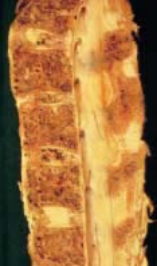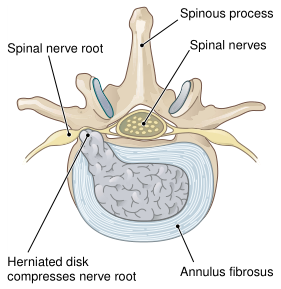Ankylosing spondylitis is a disease of the spine that appears mainly in males. Joint cartilage is destroyed; eventually the disks between the vertebrae calcify and there is fusion of the bones (ankylosis) (Fig. 1). Changes begin low in the spine and progress upward, limiting mobility.

FIGURE 1. Ankylosing spondylitis. Bone bridges fuse one vertebra to the next across the intervertebral discs and fuse the posterior portions of the vertebrae. There is osteoporosis from disuse. (Reprinted with permission from Rubin E, Farber JL. Pathology. 3rd Ed. Philadelphia: Lippincott Williams & Wilkins, 1999.)
In cases of a herniated disk (Fig. 2), the central mass (nucleus pulposus) of an intervertebral disk protrudes through the weakened outer ring (anulus fibrosus) of the disk into the spinal canal. This commonly occurs in the lumbosacral or cervical regions of the spine as a result of injury or heavy lifting. The herniated or "slipped" disk puts pressure on the spinal cord or spinal nerves, often causing pain along the sciatic nerve (sciatica). There may be spasms of the back muscles, leading to disability.

FIGURE 2. Herniated disk
A herniated disk is diagnosed by myelography, CT scan, MRI, and neuromuscular tests. Treatment is bed rest; drugs to reduce pain, muscle spasms, and inflammation; followed by an exercise program to strengthen muscles. In severe cases, it may be necessary to remove the disk surgically in a discectomy, sometimes followed by fusion of the vertebrae with a bone graft to stabilize the spine. Using techniques of microsurgery, surgery done through a small incision under magnification, it is now possible to remove an exact amount of extruded disk tissue instead of the entire disk.
责任编辑:admin
上一篇:医学文章阅读——Types of Muscle
下一篇:英语文章阅读——Arthritis

微信公众号搜索“译员”关注我们,每天为您推送翻译理论和技巧,外语学习及翻译招聘信息。